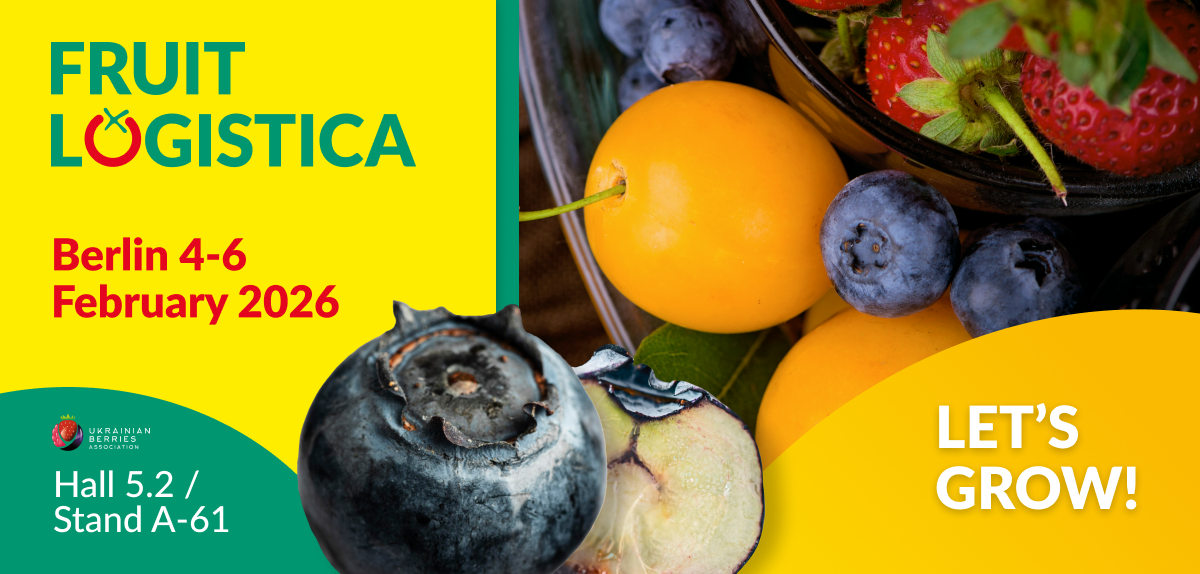
The Netherlands: Good harvest of blueberries, but large supply from various countries coming
"After a long period with Spanish and Portuguese berries, these seasons have now come to a definite end. Qualitatively speaking, the season is over. Cheap berries will still be offered from this corner, but good quality is no longer available", says a Dutch fruit trader. "For 2 or 3 weeks we have had very nice volumes of blueberries from Serbia & Romania. Price-wise we have been at a high level the last few weeks, but over the coming weeks there will be more pressure on the market when Serbia, Romania, Ukraine, Poland, the Netherlands and Germany are all on the market together. A correct planning with retail will be required to get the volume out with correct prices for the growers. The Dutch growers have beautiful fruits hanging on the bushes at the moment, so let's hope that this year the weather will not throw a spanner in the works as a result of the rain. The next few weeks will show where blueberries stand in the market and whether the volume will accumulate or continue to run well. Consumption and punnet size will be key in this."
UK: Tight market with potential gaps in supply
The blueberry harvest is under way in the UK, with the early crop from the tunnels slightly later than last year.
The tunnel blueberries have been protected from the weather, but the open ground crop may be two weeks late, which might cause a slight gap in supply.
Growing conditions at the moment are no more than average. The UK is experiencing some very heavy showers with low light levels and slightly cooler temperatures but nothing extreme.
The market is relatively tight just now with low UK production which is normal at this early stage in the season. There are some Spanish blueberries around, but the main Central European berries are not on the market yet. Things will ramp up at the end of July / beginning of August as growers move into the main open ground crop.
As always, labour is a concern for most growers, and the SAWS scheme which provides a non-European labour supply has been vital as there are very few European workers left in the UK.
Transport is also a big concern at the moment, not just in fresh produce but across all industries in the UK.
One grower commented that there is no flexibility anymore in labour supply or transport, making it very important to stick to the plan which is not easy in the fresh produce industry. Costs have increased and efficiencies have to be made which increases the pressure all round.
Spain: Season ends on a positive note as demand continues to grow
The Spanish blueberry season has ended. The harvest has been fairly staggered, with no overlap between varieties and sufficient production at each time of the season, with an excess of fruit at the end of May, as it usually happens every year. Due to the influence of the weather, volumes have been similar to those of last year, as initially expected. However, blueberry consumption continues to grow every year. Although prices have been a bit tight at the end of the season, the demand is responding and there is continuous growth. The global production is very large and the market is always supplied from various origins, leaving fewer production gaps, which facilitates regular consumption throughout the year. This helps the consumer become more familiar with the product and consume it more regularly, and all producers in all countries benefit from this. In Spain, the fruit is already on the shelves of all supermarket chains during the 12 months of the year, although in terms of volume, it still falls far behind other central and northern European countries.
This year, storm Filomena, which crossed the Iberian Peninsula in January, causing temperatures to drop, delayed the production of the early varieties for more than a month. At the same time, the cold weather brought forward the production of the late varieties. The top firms in the sector agreed that it was a risky campaign, because at that time it seemed that all varieties were going to arrive in April, and that both the early and late varieties were going to record production peaks at the same time. However, temperatures in March and April were very mild, so the peak that was expected was eventually not reached. Prospects had pointed to a year with 40-50% more volume due to the age of the trees, the hectares in production and the varieties planted, especially taking past figures into account, but this hasn't been the case. There has been a production shortage and a slow and stable supply, without any peaks. But what matters most is that prices have remained stable. While spring temperatures have allowed Huelva's blueberry campaign to avoid the concentration of the supply that was feared at the beginning of the year, in the rest of Europe the cold weather delayed both the open ground productions and those under tunnels. This allowed Spain to remain in the market for more than one month extra with good programs.
Italy: Blueberry production in full swing as market prices hold up
In Italy at the moment the national product is on the market as blueberries are now cultivated all over the country. The consumption of blueberries is clearly increasing, and Spanish product is also present on the wholesale markets. In view of the exceptional demand for Italian products, high altitude supply chains are being set up, such as the one in Val Brembana, in Lombardy.
A grower from Emilia Romagna says that harvesting started with the Duke variety some 20 days ago and is now continuing with the Bluecrop variety. Harvesting is expected to continue beyond mid-July. Their product is being purchased at around 6 euro/kg by a large commercial group. A wholesaler in Veneto says that all, or almost all, production areas in Italy are harvesting. "There is no shortage of blueberries and wholesale prices vary according to quality and size. The highest prices for a first category are around 10 Euro/kg. There is plenty of product, but at the moment the market is absorbing it."
In Piedmont, the sale of blueberries is going reasonably well both in Italy and abroad. Demand is constant, the market is good and the quality of the product is adequate. Demand for export blueberries is huge: for example, the United Kingdom prefers to buy this soft fruit over other types. In the last week, prices have dropped slightly due to the arrival of blueberries from Serbia, Croatia, Romania at lower prices. "So far, everything is going well. We are experiencing a slight drop in production due to the spring frost. We see some ups and downs in finding labour, but this is a constant every year," said a producer.
Blueberry production in Sicily has been over for a month now and activities are already underway for the next campaign. A producer who supplies a well-known cooperative specialising in the marketing of soft fruits, said that the average yield this year was around 4 kg per plant. He aims to achieve an average liquidation price of between 6 and 7 Euro/kg.
Poland: Blueberries spared effects of night frosts
The night frosts that occurred earlier this season did not have a major effect on the Polish blueberry yield this year. Blueberry production in Poland has increased steadily in recent years. Currently this growth is slowing down somewhat, but it will take time before that effect is felt in the market. The latest challenge in Polish blueberry cultivation is dealing with the spotted wing drosophila, which started to appear in 2020. It's a real concern among the growers. The season should start at a normal time again, which would be on the 10th of July.
South Africa: Large increase in blueberry production this season
The blueberry harvest in South Africa has just started, with around 6 tonnes already exported, as the Northern Hemisphere enters its late season, and blueberry growers say they’re excited about the crop and the way in which volumes are growing.
The production estimate is 36,000 tonnes and the export estimate is 25,000 tonnes, a big jump as many young orchards now reach full bearing age.
South Africa isn’t yet a big player but the industry is keen on enlarging the country’s footprint.
The domestic blueberry industry has quite changed over the past few years with the entrance of many new players, and increasing availability of blueberry cultivars outside of a tightly-controlled grower-exporter model.
According to the Johannesburg municipal market, the price is currently R92.90 (5.5 euros) per kilogram.
China: Small gap between greenhouse and field production of blueberries
At the moment, greenhouse blueberries from the South of China (south of the Yangzi river) are mostly off the market. Field blueberries will be soon arriving on the market.
July and August are the peak season of blueberries from the North-East region. Currently the harvest of field blueberries is just beginning, leaving the market with a small gap between productions.
In recent years, many foreign investments have begun joint ventures with Chinese companies, to build up blueberry production greenhouse in the Yunnan province. Yunnan blueberry's production volume and quality are gradually improving year by year.
For field blueberry production, Shandong is an important production area. The conditions are excellent for blueberry cultivation. The coastal climate is mild and well-suited for blueberry production.
Chinese companies are seeking more new varieties of blueberry.
North America: Lower supply due to heat wave leads to stable prices
As blueberry supplies move north in North America, supplies are currently tighter than anticipated.
According to one California based trader, they finished their California season two weeks ago and moved to Oregon for supplies starting June 18th. Then in late June, the heat wave that affected large swaths of the West Coast hit and the trader says growers’ reporting issues were inconsistent--some reported no problems on their crops while others saw full crops of sunburnt blueberries. Oregon typically stays in production until the end of July.
Also starting later this week is the Washington production. “The reports I’m getting so far is that there isn’t any damage on the fruit but that doesn’t mean there aren’t any issues,” says the trader. British Columbia is also starting with production and, having also experienced that same heat wave, growers on the Eastern part of the province look to be more affected than growers in the Western part of the province. “The closer you are to the water, the less you suffered,” they note.
That said, eyes are watchful on all Pacific Northwest crops to see the effects from the heat.
On the other side of the country, the trader says that there’s low production coming still out of the Southeast though that fruit is primarily supplying Southeast customers. New Jersey is supplying the Northeast, though reports are that there is less fruit than originally anticipated, and Michigan is also starting with production.
On the other side of the equation, demand is currently stronger than usual, even after the 4th of July weekend.
Whether that demand stays strong is still to be determined. “Over the last year or two, there is more interest in bigger packs. The bigger packs show consumption at home to me,” says the trader. “And if supplies remain tight, there’ll be great demand for fruit until the end of summer.”
All of this leaves pricing stable.
Looking ahead at imports, while September is when retailers start working on switching over to imported fruit from Peru, Peru itself continues to shift where it sends its early volumes. “They will have volume earlier again. But they’re also focusing their first couple of months more on Asia because the U.S. still has domestic production at that time,” the trader concludes. “I think each year they'll do more and more of that until the U.S. starts running out of production.”
Australia & New Zealand: Value of NZ blueberry exports continues to grow significantly
The value of New Zealand's blueberry exports continues to grow each year, according to the latest data reports. For the year ending June 2020, the value was NZ$44million, up from $38.9m in 2019. It has progressively been climbing and was only $6m in 2000 and $23.4m in 2015. Australia was the main destination for blueberry exports last year, accounting for $39m of the value. The report also showed that there were 80 growers nationwide, producing 3,640 tonnes, with domestic sales of the fruit at $35.3million.
In Australia, the Northern NSW season got underway last month, which has seen retail prices reduce to as low as A$4.00-A$4.50 after rising through the autumn when the fruit was out of season after the completion of the southern states production seasons.
Source: FreshPlaza

 En
En  Укр
Укр 



